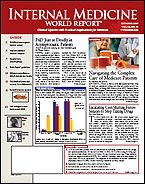Publication
Article
Internal Medicine World Report
Low Estrogen Levels in Men Linked to Low BMD
Author(s):
TORONTO, Canada—It is well-known that estradiol influences bone mineral density (BMD) in women. A new study presented at the Endocrine Society's annual meeting now shows a strong association between serum estradiol, testosterone, and sex hormone?binding globulin (SHBG) and BMD level in men.
Adrian Dobs, MD
This study looked at 1220 men (aged 20-90 years) who had participated in phase 1 of the Third National Health and Nutrition Examination Survey. Men with lower estradiol levels, lower free testosterone levels, and higher circulating SHBG concentrations were more likely to have low BMD. This relationship held true even when taking into account other risk factors known to influence BMD.
"This is new information. Everyone thinks only in terms of testosterone as good in the bones, and that is why men have a higher bone mineral density than women do, but in reality it looks like estradiol is even more important at the bone level," said coinvestigator Adrian Dobs, MD, professor of medicine and oncology, Division of Endocrinology and Metabolism, Johns Hopkins School of Medicine.
These findings are the first to show such an association in a large, nationally representative sample of civilian, community-dwelling men across a wide age range.
The investigators measured BMD of the proximal femur using dual-energy x-ray absorptiometry. Serum samples were evaluated for estradiol, testosterone, and SHBG concentrations using competitive electrochemiluminescence immunoassays. Mass action equations were used to calculate free estradiol and free testosterone levels.
Low BMD level was defined as ≥1 SD below the mean for healthy men aged 20 to 30, a definition that encompasses osteopenia and osteoporosis. The men were divided into quartiles based on hormone concentrations levels. Those in the lowest quartile of free estradiol were almost 3 times more likely to have low BMD than men in the highest quartile.
In addition, men in the lower 3 quartiles of free testosterone were more likely to have low BMD than those in the highest quartile. And lower concentrations of SHBG appeared to be protective against low levels of BMD.
Men with clinically low serum estradiol levels (< 20 pg/mL) had lower BMD than men with normal levels. Dr Dobs noted that the association with free estradiol level was more pronounced among middle-aged and elderly men, but no significant age-related differences were found for free testosterone and SHBG.
IMWR
"Overall, we found that individuals with thin bones were more likely to have low testosterone and low estrogen levels. However, it was particularly true for estrogen. So it looks like estrogen is what is really required to make bones stronger. This is consistent with some other data that show there are estrogen receptors in the bone, and men and women need to have a certain level of estrogen circulating in their bloodstream. Estrogen will attach to the bone and will increase the strength and the bone density," Dr Dobs told .
Primary care physicians may want to consider measuring testosterone levels in men who are diagnosed with osteopenia or osteoporosis. If testosterone levels are low, it may be appropriate to use testosterone therapy to try to halt bone loss, Dr Dobs said. This could be achieved by using a testosterone preparation that can be metabolized to estradiol.
"The take-home message is not that we are recommending that men be treated with estrogen if they are found to have osteopenia or osteoporosis, because that would be associated with too many unwanted side effects. However, we do think if a man has thin bones, then he should be treated with testosterone or another agent to strengthen bones," said Dr Dobs.





